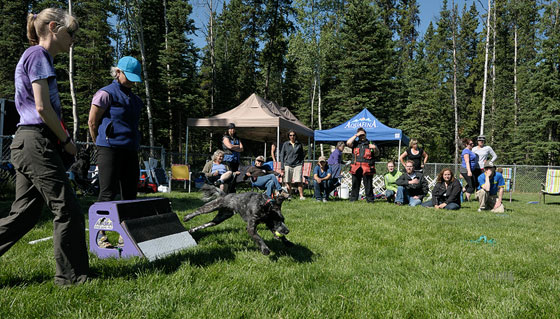
Photo by Vince Fedoroff
FOLLOW MY LEAD – Stacy Smith, left, the regional director for flyball in Alaska, watches on as Gus, an English cocker spaniel, retrieves a ball during the weekend flyball workshop hosted at the Hidden Valley school grounds.

Photo by Vince Fedoroff
FOLLOW MY LEAD – Stacy Smith, left, the regional director for flyball in Alaska, watches on as Gus, an English cocker spaniel, retrieves a ball during the weekend flyball workshop hosted at the Hidden Valley school grounds.
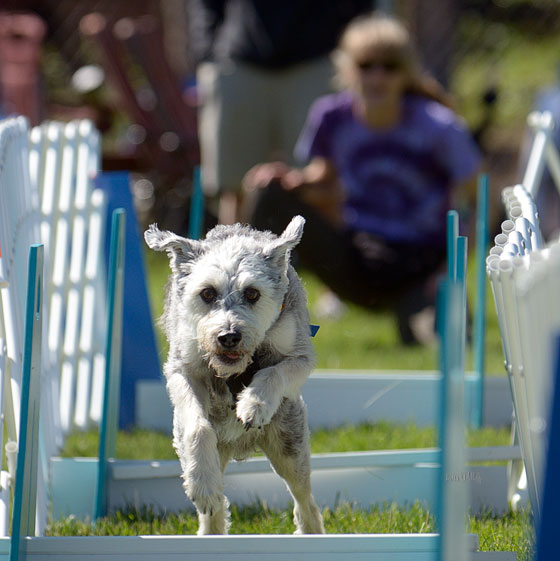
Photo by Vince Fedoroff
ALMOST THERE – Moxy goes for a run during the flyball workshop. Seventeen handlers and 21 dogs took part in the weekend meet. There are over 400 active flyball clubs in North America.
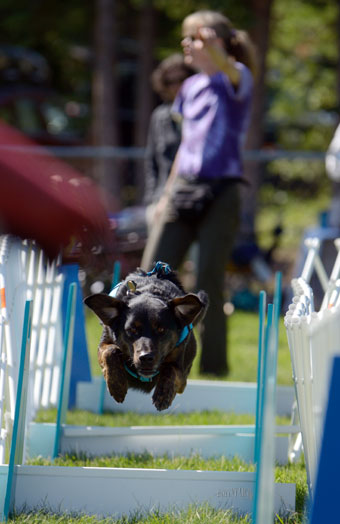
Photo by Vince Fedoroff
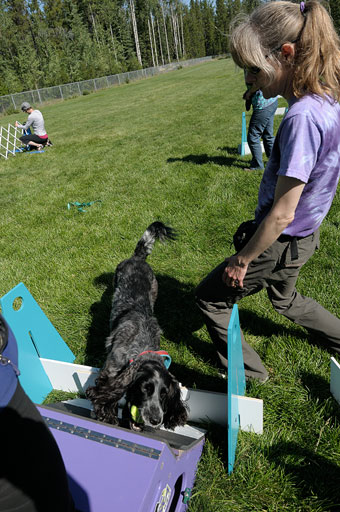
Photo by Vince Fedoroff
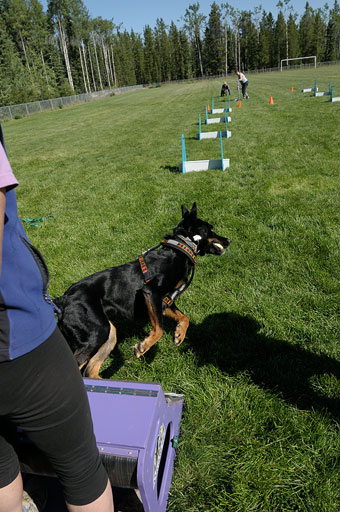
Photo by Vince Fedoroff
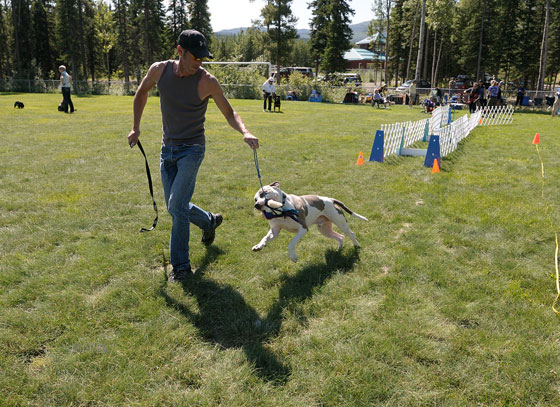
Photo by Vince Fedoroff
Local dog-handlers and canines took playing fetch to a new level this weekend.
Local dog-handlers and canines took playing fetch to a new level this weekend.
The Yukon K9 Performance Group joined forces with the Anchorage-based club Alaska Dogs Gone Wild to put on a two-day flyball workshop at the Hidden Valley School grounds.
The meet was the first step in introducing the sport to the Whitehorse area.
Seventeen people and 21 dogs attended the weekend session, including Gus and Ginny, stars of the Alaska flyball circuit.
Alaskan handlers Stacy Smith, Jaime Muhr and Chris Sitbon also accompanied the dogs.
Flyball is a team sport, featuring four dogs per side, racing over a 51-foot long course.
The dogs take off from the starting line, jumping four hurdles spaced 10 feet apart, retrieve a tennis ball from a spring loaded box and then return.
The course is timed and dogs earn points based on their speed. The first team to have all four dogs cross the finish line without error wins the heat.
The height of the jumps are determined by the smallest dog on the team, deemed the "height dog.”
The minimum height is seven inches while the maximum is 14.
There are more than 400 active flyball clubs scattered across 22 regions in North America and the non-profit North American Flyball Association (NAFA) sanctions the sport.
Smith also serves as the regional director for flyball in Alaska, recognized as Region 18 by NAFA.
The workshop focused on introducing the sport to the dogs and handlers and teaching the dogs how to run the course.
Gus, an English cocker spaniel, and Ginny, a bernese mountain dog and black lab mix who was also the crowned the 2011 Region 18 MVP, set a high standard for the local dogs, displaying their experience and skills.
Another Alaskan based pooch, Rugby, a border collie and Staffordshire bull terrier mix, was also brought up to participate.
Rugby, brimming with personality, was another star on the course, displaying his energy and moxie.
Diane Lister, a member of the Yukon K9 Performance Group, said the Whitehorse dogs showed a lot of skill and promise over the course of the workshop, which was "well-attended and well received.”
"The instructors from Anchorage were actually very impressed with the level of training with the dogs that were there,” she said.
"The dogs were very keen to engage in rewards which is really important in flyball, that the dog is revved up to work for the reward.”
After completing the course the dogs are rewarded with a treat, a tug toy or any another desired item.
"That takes some work on the part of the handler to develop that in a dog,” said Lister of the dogs' desire to compete and earn a reward.
"So it was nice for us to hear that we do have a good foundation with a lot of the dogs.”
Lister said the dogs and the club is a few years away from being ready to compete but many left the workshop with a newfound interest and anticipation for the next workshop.
"There might not be a big rush for us to join the association at this point but we'll keep in touch and hope we can do some more workshops,” said Lister.
Lister also mentioned the possibility of local handlers travelling to Alaska to gain more knowledge and expertise of the sport.
"All of us left with a good idea of where we need to work individually with our dogs,” said Lister.
"There are a lot of training elements that a person does in their own time and in their own space.”
The club will be polling the participants to gauge a level of interest and from there decide how to handle the sport moving forward.
"I think most of them left with a interest,” said Lister.
"How serious you want to get about it is really the question. How much time you'd like to devote it and where you see it going is what we need to answer and from there we can collectively work out how we'd like to pursue the sport.”
If flyball proves to be successful in the Whitehorse area, a new chapter could register with NAFA and join the Alaska region.
One obstacle that could prevent any growth from taking place is a lack of facilities in the winter.
"It's an issue that keeps coming up,” said Lister.
"It's not only our club but all the other clubs,” she said, noting that the Whitehorse Woofers have investigated other options but have been frustrated with pricing.
"They just keep coming up as very expensive and more than a dog owner can afford to pay,” she said.
"It's an important service to have places where you can train and develop your dogs.
"Having good dog citizens is an important aspect to Whitehorse.”
In order to encourage thoughtful and responsible discussion, website comments will not be visible until a moderator approves them. Please add comments judiciously and refrain from maligning any individual or institution. Read about our user comment and privacy policies.
Your name and email address are required before your comment is posted. Otherwise, your comment will not be posted.
Comments (1)
Up 0 Down 0
local dogperson on Jul 30, 2012 at 8:59 pm
Is flyball related to AKC and will there be any competitions coming up in Whitehorse? Does it take very long to teach a dog how to do it and to get 4 dogs ready to have a team?